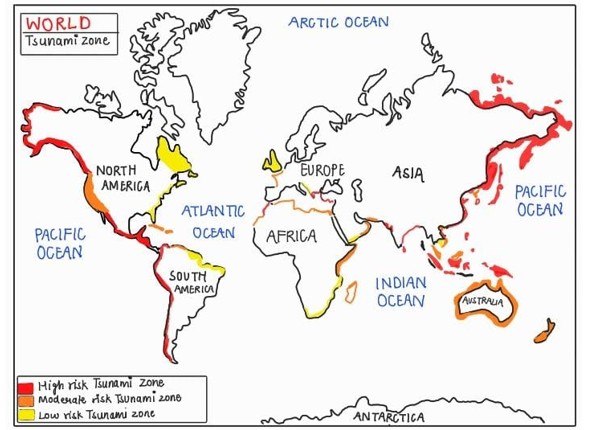Core Demand of the Question
- What are Tsunamis (Introduction)
- How Tsunamis are Formed
- Where Tsunamis are Formed
- Consequences of Tsunamis
|
Introduction
Tsunamis are series of large sea waves generated by sudden displacement of seawater due to undersea earthquakes, volcanic eruptions, or landslides. They travel at high speeds across oceans and cause massive destruction upon reaching shallow coastal areas.
Body
How Tsunamis are Formed
- Undersea Earthquakes: Subduction zone quakes cause vertical seabed displacement, pushing water upward. This sudden uplift generates powerful waves that evolve into tsunamis.
- Eg: The 2004 Indian Ocean tsunami from a 9.1 magnitude quake near Sumatra.
- Volcanic Eruptions: Submarine eruptions or the collapse of volcanic flanks displace huge water volumes.
- Eg: 1883 Krakatoa eruption, Indonesia.
- Landslides/Glacier Falls: Coastal or submarine landslides push water upward, creating localized tsunamis.
- Eg: 1958 Lituya Bay, Alaska, produced a 500 m wave.
Where Tsunamis are Formed
- Pacific Ocean (Ring of Fire): Most tsunamis originate here due to intense tectonic subduction zones (Japan, Chile, Alaska).
- Indian Ocean Margins: Seismic zones like the Sunda Trench near Sumatra and the Andaman–Nicobar region.
- Mediterranean and Atlantic: Smaller but destructive tsunamis from submarine quakes and landslides (Lisbon 1755 earthquake).
- Polar Regions: Glacial collapses in Greenland and Alaska sometimes trigger local tsunamis.

Fig: Tsunami Zones
Consequences of Tsunamis
- Human Losses and Displacement: Large coastal populations face massive casualties and forced migration.
- Eg: The 2004 Indian Ocean tsunami killed over 2.3 lakh people.
- Economic and Infrastructure Damage: Ports, fisheries, industries, and tourism infrastructure collapse under inundation.
- Eg: The 2011 Japan tsunami caused $235 billion in damages.
- Environmental Degradation: Saltwater intrusion into groundwater and farmland, along with mangrove destruction, disrupt ecosystems.
- Eg: In Tamil Nadu (2004), extensive paddy fields turned saline and unproductive.
- Public Health and Social Crisis: Spread of diseases, scarcity of drinking water, and psychological trauma prolong recovery.
- Eg: Cholera and diarrheal outbreaks occurred in Sri Lanka and Indonesia post-2004.
Conclusion
Tsunamis highlight the intersection of natural hazards and human settlements. Investing in resilient infrastructure and regional cooperation ensures both safety and sustainable development.
